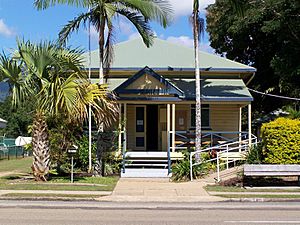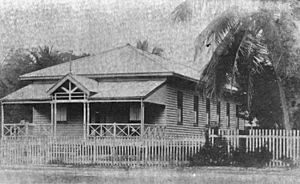Cardwell Divisional Board Hall facts for kids
Quick facts for kids Cardwell Divisional Board Hall |
|
|---|---|

Cardwell Divisional Board Hall, 2008
|
|
| Location | 51 Victoria Street, Cardwell, Cassowary Coast Region, Queensland, Australia |
| Built | 1892 |
| Architectural style(s) | Classicism |
| Official name: Cardwell Divisional Board Hall (former) and Honour Board, JC Hubinger Memorial Museum, JC Hubinger Museum, JC Hubinger Memorial Hall | |
| Type | state heritage (built) |
| Designated | 21 March 2013 |
| Reference no. | 601768 |
| Significant period | 1892-1929 |
| Significant components | stage/sound shell |
| Lua error in Module:Location_map at line 420: attempt to index field 'wikibase' (a nil value). | |
The Cardwell Divisional Board Hall is a special old building in Cardwell. It used to be a town hall. Today, it is known by many names, including the Cardwell Shire Chambers and the JC Hubinger Memorial Museum. This hall and a special board inside it, which remembers soldiers from World War I, were added to the Queensland Heritage Register in 2013. This means they are protected because of their important history.
Contents
History of the Hall
The Cardwell Divisional Board Hall was built in 1892. It is in an old government area on Victoria Street in Cardwell. Not many buildings made for "divisional boards" (early local government groups) are still standing in Queensland.
In 1903, the building became the Cardwell Shire Hall. A special marble board, called an honour board, was added in 1922. This board lists the names of people from the area who served in World War I.
After 1929, the local government offices moved to Tully. The hall then had many different uses. It was used by the Queensland Country Women's Association (QCWA). Later, it was used by the Returned Sailors' Soldiers' and Airmen's Imperial League of Australia (RSSAILA), a group for returned soldiers. From 1989 to 2008, it was a library. Now, it is part of the Cardwell Bush Telegraph Heritage Centre and is called the JC Hubinger Museum.
Cardwell's Early Days
Cardwell was one of the first European settlements in North Queensland. It started in 1864 when a group led by George Elphinstone Dalrymple arrived. They hoped to create a new port and a road to the inland areas. The town was first called Port Hinchinbrook. Later, Governor Bowen changed its name to Cardwell. This was to honour Edward Cardwell, a British government official.
A special area in the new town was set aside for government buildings. This area included the school, police station, Post and Telegraph Office, and later, the Divisional Board Hall. Cardwell was meant to be an important port. However, it faced challenges. The Cardwell Range mountains made it hard to reach the inland. Also, shallow waters near the coast made it difficult for large ships. Soon, Townsville became the main port in the region.
Even though Cardwell didn't grow as expected, the government kept many services there. This made government work the main industry in the town. By the 1870s, Cardwell had a pilot's quarters, police barracks, a courthouse, and a Telegraph Office.
Local Government in Cardwell
In 1884, the Cardwell Divisional Board was created. This was a new local government group for the area. Before this, the central government in Queensland handled many local issues. To make things easier, new laws were passed in 1878 and 1879. These laws created "divisional boards" to manage rural areas. Each board had members who looked after local matters.
The Cardwell Divisional Board covered a very large area. It was about 18,130 square kilometres. At first, it was hard to get people to join the board. Meetings were also difficult to hold because of the large area and travel challenges.
The Cardwell Divisional Board first met in the old courthouse. But a cyclone in 1890 badly damaged that building. A new, smaller courthouse was built. This meant a new public building was needed for board meetings and community events. So, the Cardwell Divisional Board Hall was built in 1892-1893. It cost about £320. The hall was designed for two purposes. It had a stage for performances and a workroom at the back.
The Hall as Shire Chambers
In 1903, the Cardwell Divisional Board became the Cardwell Shire Council. The hall continued to be used for council meetings.
In 1922, a special honour board was added to the hall. This board was made of heavy marble by a company called Melrose and Fenwick. It listed the names of 26 men and 2 nurses from the Cardwell area who served in World War I. Two of the men listed had died in the war. The Premier of Queensland, Ted Theodore, officially unveiled the honour board in May 1922.
During the 1920s, the nearby town of Tully grew much faster than Cardwell. Tully became a major sugar-mill town. In 1929, the main offices for the Cardwell Shire Council moved to Tully. Even so, the honour board stayed in the Cardwell hall.
Later Uses and Restoration
After the council moved out, the hall was leased to the Queensland Country Women's Association (QCWA) in 1929. The hall was also used for ceremonies by the RSSILA, the soldiers' group. In 1945, the Cardwell Shire gave the hall to the RSSILA. It was then called the "Diggers Memorial Hall."
Over the years, the hall was used for many community events. These included political meetings, property auctions, and dances. During World War II, soldiers even stayed in the hall for a short time in 1942. Musical shows and plays were also held there. Some performers even left their names on the walls of the dressing rooms.
By the 1980s, the hall was getting old and needed repairs. The community strongly wanted to save it. So, in 1988, it was decided to restore the hall as a special project. The work included fixing the foundations and floors. An old room at the back had to be removed because it was badly damaged. The community also insisted that the honour board stay in the hall.
The hall officially reopened in January 1989. It was named the JC Hubinger Memorial Library. This was to honour Johann Christian Hubinger. He was the chairman of the Cardwell Divisional Board and Shire Council many times. He was a German immigrant and a well-known businessman in Cardwell.
In 2008, the library moved to a new location. But the hall continued to be a museum. It is part of the Cardwell Bush Telegraph Heritage Centre. This centre also includes the old courthouse and lock-up. The hall was also used for the annual ANZAC Day dawn service.
In February 2011, Cyclone Yasi heavily damaged the hall. But because the community loved the hall and wanted the honour board to stay there, it was rebuilt. Most of it was restored to look like it did originally. The stage, dressing rooms, honour board, and the original council table were saved. The hall officially reopened in October 2012.
Not many other divisional board halls like this one are still around in Queensland. Most were simple timber buildings that were taken down or sold.
What the Hall Looks Like
The former Cardwell Divisional Board Hall is at the southern end of Cardwell's main street, Victoria Street. It is next to the old Telegraph Office. The hall faces the beach and the Coral Sea. It sits in the middle of its block of land.
The hall is a simple, single-storey timber building. It is built on timber stumps and has a roof made of corrugated metal. The front has a verandah with a central gable roof. The verandah has pairs of posts and a criss-cross railing.
The building has many windows and doors. There are double doors at the front. On each side, there are six windows. Two pairs of doors are at the back.
Inside, the walls are covered with timber boards. There is a raised timber stage at the back. Two small rooms are on either side of the stage. A large, beautiful marble honour board is fixed to the wall on the stage. It lists the names of 26 men and 2 nurses who served in World War I. The honour board has classic design elements like columns and a triangular top. It is supported by a strong timber frame.
You can also see the original table used by the Cardwell Divisional Board inside the hall. This table, the honour board, and the original stage area are very important parts of the hall's history.
Outside, there are two large trees near the old telegraph office. A concrete ramp on the side of the verandah helps people get inside. There is also a separate toilet building. These newer parts are not considered part of the historical listing. Behind the hall are two other old timber buildings, a former courthouse and a lock-up. These are also important to local history.
Why the Hall is Special
The former Cardwell Divisional Board Hall and its Honour Board were added to the Queensland Heritage Register in 2013. This is because they meet several important criteria.
Showing Queensland's History
The hall, built in 1892, shows how local government started and grew in Queensland. Very few buildings made specifically for "divisional boards" still exist. The hall's simple design and small size show what these early local government groups were like. The hall's location also reminds us that Cardwell was once the main town in the area.
The World War I honour board is a record of Queensland's part in a major world event. Honour boards are a way to remember those who served or died from a community. They are often the focus of ANZAC Day ceremonies. They show how communities across Queensland and Australia remember their heroes.
Unique Characteristics
The Cardwell World War I honour board is a great example of its kind. It is placed in a very important spot inside the hall. It is a beautiful and rich example for a small community. It is made of fine marble with gold and lead lettering. It shows the names of 26 men and 2 nurses in a respectful way. It is rare to see nurses listed on an honour board in Queensland.
Beautiful Design
The Cardwell World War I honour board is important for its beauty. It is carefully designed with classic shapes. It uses contrasting red and white marble. It is placed at the stage end of the hall. This makes it a dignified place to remember those involved in the war.
Strong Community Connection
The former Cardwell Divisional Board Hall has a long and special connection with the people of the Cardwell District. It has been used for many public events. It was a government office, a theatre, a meeting place for the Country Women's Association, an ANZAC Day site, a party venue, a library, and a museum. These uses have created strong ties with the community. The community's love for the hall helped save it from being torn down in the 1980s. It also made sure it was rebuilt after Cyclone Yasi in 2011.
The community's strong feelings for the hall's honour board show how much these memorials mean across Australia. As a place for ANZAC Day ceremonies, it is highly valued by the community for its meaning and importance.
Images for kids



